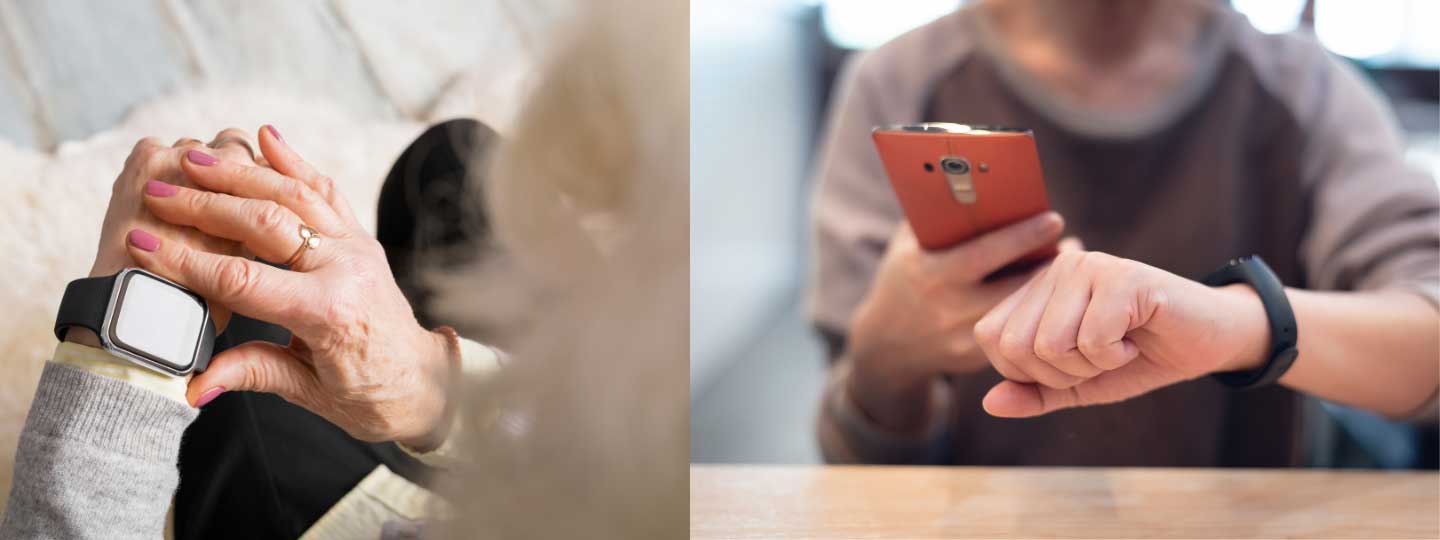Wearable devices: how is tracking movement helping research?
10 December 2020
As we all know, wearable devices that we use to track movement are becoming a big part of our lives.
We recently came across the largest ever study using wearable devices, involving over 96,000 participants. Previously it has been difficult to carry out questionnaire-based studies on physical activity as every day movements are hard to recall accurately, but of course using wearable devices leads to much more reliable measurements. Researchers in this study found that any physical activity is beneficial for health, but more intense activity has greater benefits.
We don’t fund this study, but it really got us thinking about the research we do fund using wearable devices to track exercise or movement, and how these technologies could benefit people with arthritis.
Being active can reduce pain
Previous research has shown physical activity can reduce the amount of pain people have in their joints, but many people in older age groups find it hard to be active.
We’re funding a knee pain study aiming to find out if a walking programme called iPOPP will encourage people over the age of 65, with joint pain, to be more active.
People on the programme will have two consultations with a healthcare assistant, be given a pedometer (also known as a step counter), a pain toolkit, a diary and sent motivational prompts.
It’s hoped that increasing physical activity levels in older people with long-term joint pain will lead to less pain, greater physical function, improved mental health, and overall quality of life. Read more about looking after your wellbeing.
Tracking your steps
Another project involving the use of a step counter, is Walk with Ease. It’s a community-based walking programme designed for people with arthritis/ musculoskeletal conditions, which has been a success in the US.
The project we are funding is adapting the programme to ensure its relevance and adoption in a UK setting. If it’s found to be possible then there is potential for this programme to become a prescribed treatment for arthritis/musculoskeletal conditions.
This would positively transform health and quality of life for people living with these conditions, giving them greater control to better self-manage their condition with increased physical activity.
What devices are we developing to help people with musculoskeletal conditions?
We’ve talked about a couple of projects that are using wearable devices, here’s a couple that are working to develop devices to treat people living with musculoskeletal conditions.
Helping to reduce pain
People living with complex regional pain syndrome have severe, persistent limb pain, and have trouble with sensory discrimination (identifying difference between textures) with even gentle touch feeling painful.
Some of our researchers are developing a device that people with the condition can use at home to help treat persistent pain, improve limb sensation and reduce pain.
The device delivers a pleasant sensation to the affected limb to help patients feel normal sensations instead of painful ones.
This technology could also have broader applications for improving quality of life of people with arthritis and neuropathic pain, including people with chronic lower back pain and survivors of stroke.
Monitoring muscle inflammation
Idiopathic inflammatory myopathies are a group of conditions that cause muscle inflammation, which is termed myositis. If left untreated muscle inflammation can irreversibly damage the muscle and lead to disability.
Usually the level of inflammation is assessed during hospital appointments, however muscle inflammation may worsen or flare up between appointments, causing muscle damage or weakness.
Researchers we fund are therefore hoping to develop and test a system to continuously monitor myositis in order to improve treatment and prevent irreversible muscle damage. It will involve an app that people with myositis use daily to fill out questionnaires about their disease activity, as well as wearing a small device to measure changes in walking pattern, which is a marker of muscle inflammation.
If successfully developed for clinical use it could allow constant, remote monitoring of people with inflammation so that doctors can be notified of worsening myositis. This could lead to quicker treatment and prevent potential muscle damage and disability.
Find out more about our research
We’ll keep you posted on progress and updates. In the meantime, find out more about our research.
We’re here for you
- If you would like to talk to someone, you can call our free helpline on 0800 5200 520
- Chat to our Arthritis Virtual Assistant.
- Join our online community
- Stay in touch and follow us on Twitter, Facebook and Instagram.